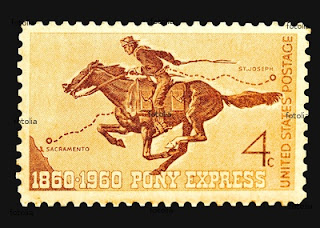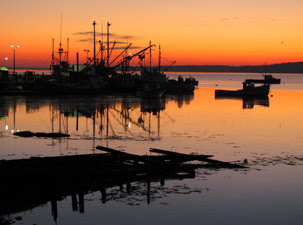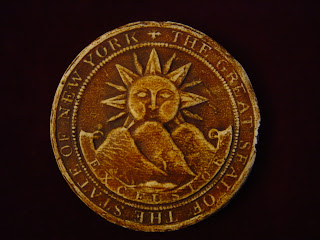On August 20, 1950, Hawaii became the 50th state of the Union...
You might expect a modern, tropical paradise like Hawaii to choose a flag the color of the ocean, or to include a volcano or two. After all, Hawaii is home to the world's largest and most active volcano. You might think the flag would include pineapples or coffee beans – the foods or flora the 8 islands are famous for.
You would be completely wrong.
To look at the Hawaiian flag is to look at centuries of negotiation and alliance with two countries: England and the United States.
 |
| King Ka-meha-meha I (rootsweb) |
Originally, each of the 8 islands that make up the state of Hawaii – the most isolated occupied land mass on the planet – had a different king. King Ka-meha-meha I, however, is the king that united the Hawaiian islands.
It also was during Ka-me-ha-me-ha's reign, that Hawaii sought England's protection. Discovered by Captain Cook by accident in 1788 (Cook was looking for the northern coast of California), Hawaii was familiar with English ships and English trade.
On Feb. 21, 1794, Hawaii officially became a protectorate of England.
 |
| King James' flag, probably what Hawaii flew, c. 1794 |
According to some sources, this first Union Jack to fly over Hawaii was the version flown by King James from 1603-1625.
 | |
| The British "Union Jack" |
 |
| The sea flag of czarist Russia |
The King James' flag would have been replaced by the now-familiar, second Union Jack in 1801.
While Hawaii and King Ka-meha-meha were flying the English flag, over on Kauai, they were flying the Russian flag!
This remained a small bone of contention between the two islands but Kauai would continue to fly the Russian flag for quite some time, even as King Ka-meha-meha conquered the other islands and brought the Union Jack with him.
Legend has it that years later, during the War of 1812, an American visitor and friend of the king encouraged him to fly his own flag. The thinking was that a sovereign flag may be thought to be less provocative to fly during war than flying England's Union Jack.
Whether this is true or not, it certainly makes sense and corresponds with King Ka-meha-meha's timing for the design of his flag, a forerunner of the current flag for the state of Hawaii.
 |
| The Hawaii state flag |
The new Hawaiian flag was a clever mixing of the English flag and the Star-Spangled Banner, a hybrid to the current flag for the state of Hawaii . It included a small Union Jack in the design as well as several red, white and blue stripes. While the stripes are the colors of the Unites States' flag, the number of stripes is said to represent each of the Hawaiian islands. When the new flag was flown, it flew everywhere – including Kauai where it replaced the Russian flag.
 |
| King Kamehameha III (rootsweb) |
In 1843, a sea-faring English lord seized the Hawaiian islands from King Ka-meha-meha III. For four months, Lord Paulet taxed the people, impressed them into military service, and ruled, seemingly with impunity. King Ka meha-meha III, however, sent word to England, asking for help.
That June, an American ship sailed into port and King Ka meha-meha III wasted no time before appealing to the Americans. The Americans responded favorably by recognizing the legitimate government of Hawaii and not Paulet's pretend kingdom. In point of fact, the Americans responded by raising a hastily made version of the Hawaiian flag as all others had been burnt by Paulet.
 |
| A model of Captain Cook's Endeavor |
Just days later, another ship sailed into harbor, this one under order from the English king to restore Hawaii's independence. Paulet's usurpation was over.
A celebration was organized on July 31, 1843. A proclamation was read declaring Hawaii's restored status as an independent nation under the protectorate of England. King Ka meha-meha gave a speech. There were parades. The Hawaiian anthem was sung. It was, by all reports, a glorious day.
From King Ka meha-meha's speech that day, a statement was taken and was adopted as the state motto. Translated into English, it says:
"The perpetuation of the life of the land
depends upon righteousness."
In the years between 1849-1851, the French discovered Hawaii and created enough difficulty that Hawaii thought it more practical to be placed under the protection of the much closer United States. A new contract was negotiated.
 |
| Queen Lilio'okalani (rootsweb) |
In 1893, as the century was rapidly closing, the queen of the Hawaiian islands attempted a coup. It lasted all of three days, ending on January 17 when the United States Navy landed and restored order. The local Committee for Safety issued a proclamation that nullified the kingdom, authorized a temporary government, and placed the islands under "the control and management" of the United States.
This arrangement lasted an entire two months before an independent Hawaii was restored.
Then in 1898, President McKinley illegally annexed Hawaii for the United States (the Newland Resolution). This was remedied in 1900 with Hawaii becoming an official Territory of the United States and, in 1901, forming its first congressional delegation.
Finally, in 1959, after a popular referendum in which over 90% of the vote supported Hawaii becoming the 50th state, President Dwight Eisenhower signed the act that brought Hawaii its statehood.
Ho'omaika'i 'ana, Hawa'ii! (Congratulations, Hawaii!)
Let if fly!
To find find out how to fly the flag and other flag etiquette, see USFlagstore's Flag Etiquette 101 and USFlagstore's How to Fly the Flag at Half-Staff.
































